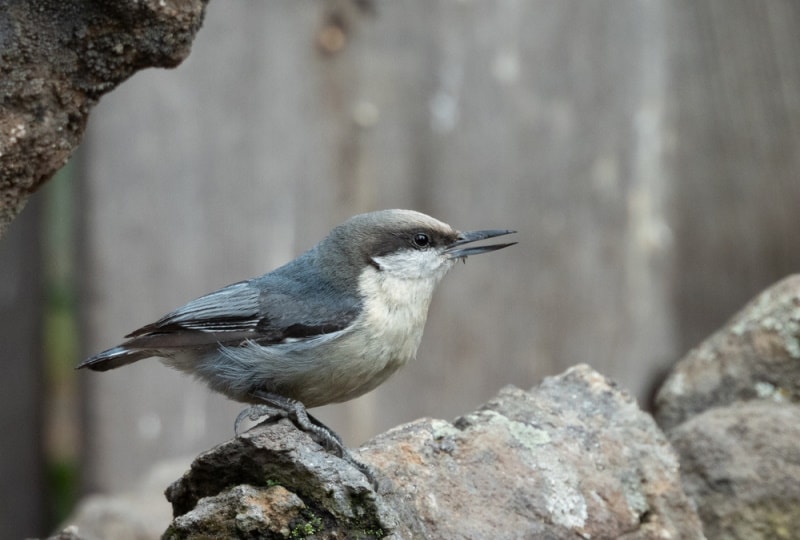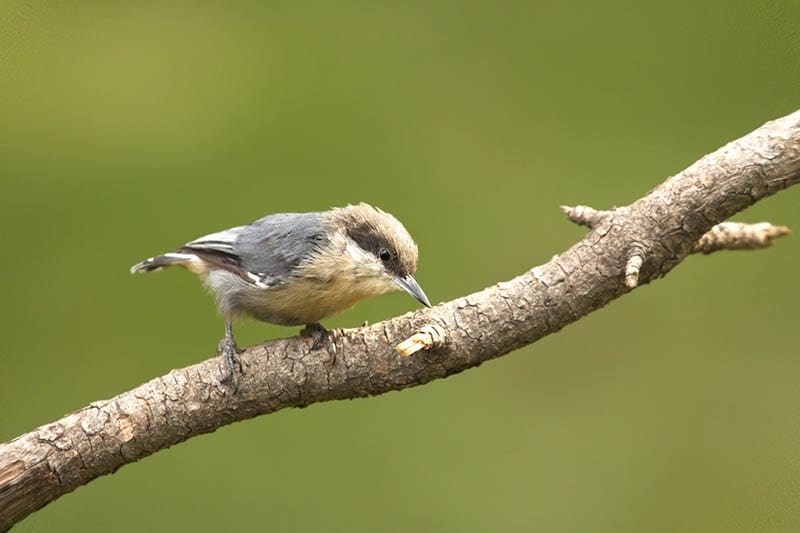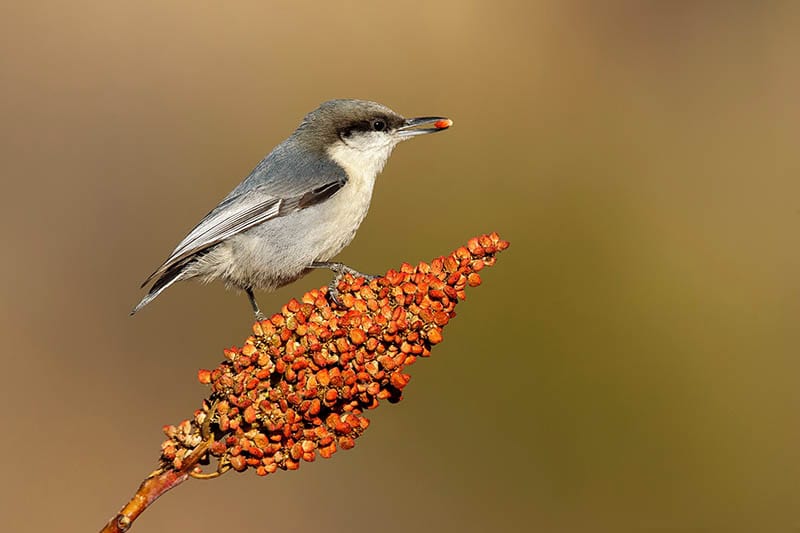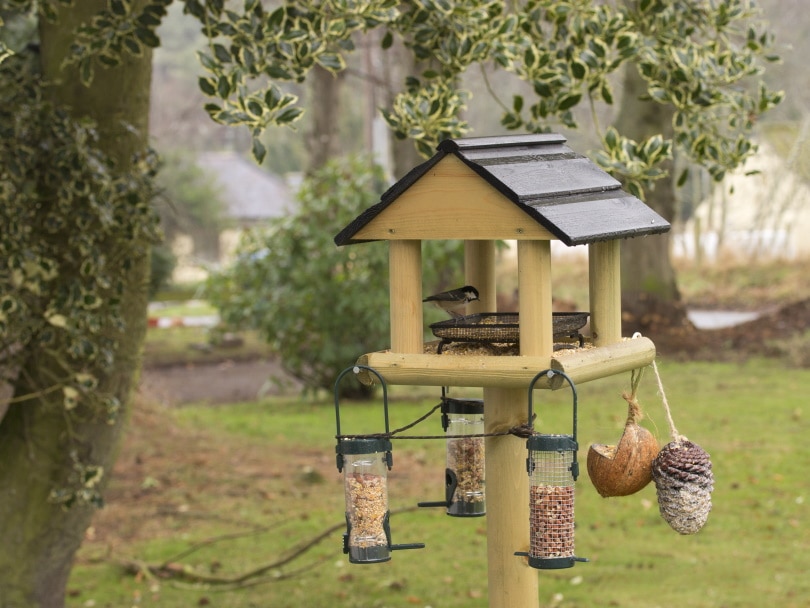Pygmy Nuthatch: Field Guide, Pictures, Habitat & Info
Last Updated on

The Pygmy Nuthatches are one of the native North American songbirds primarily seen in the western pine forests. These acrobatic birds are popular for their nest building. The breeding pairs build nests with the entire family’s help, including young offspring and relatives. These nest helpers also protect the nest from predators.
Pygmy Nuthatches prefer flying in small flocks over the highest trees, cones, and tall pines’ needle clusters. These all-year birds spend the cold days with a small flock in a tree cavity.
A Pygmy Nuthatch is an adorable buffy bird with a white, brown, gray, and black color combination. Let’s know about these birds’ habitat, range, and diet and how you can attract them to your backyard.

Quick Facts About Pygmy Nuthatches
| Habitat | Forests |
| Diet | Insects |
| Behavior | Bark forager |
| Nesting | Cavity |
| Conservation | Low concern |
| Scientific name | Sitta pygmaea |
| Lifespan | 8 years |
Pygmy Nuthatch: General Description
Compared to other Nuthatch species, Pygmy Nuthatches are smaller and more active birds with a straight, sharp bill. On your visit to a ponderosa pine forest, you’re likely to see these birds climbing up and down, giving duck-like calls to their mates.
Pygmy Nuthatches are the resident birds of the older ponderosa pines in the western open forests. These adorable birds have white underparts with classic brown heads. Their bill is slate-gray or black.
You will rarely find a Nuthatch alone. These birds prefer living, flying, and breeding in a large family. In fact, they like to spend the winter with a group of 10–15 birds in an old tree cavity; most of them are nest helpers.

Pygmy Nuthatch: Range, Habitat, Behavior, Diet & Nesting
Pygmy Nuthatches are lovely birds with a beautiful melodious voice. These hyperenergetic birds make the pine forests an attractive site for birdwatchers. If you’re planning to go to an open forest to see these birds, here is everything you need to know:
Range
Pygmy Nuthatch is a nonmigratory bird species. They build nests with their family members in summer and spring, take care of their offspring, and go into the cavities in the winter. No matter how harsh the weather, these birds never travel to nearby places for food or shelter.
Habitat
Long-needled pine forests are the favorite places for Pygmy Nuthatches to live. They prefer ponderosa pines but are also seen in other pines like Bishop, Jeffrey, Arizona white pine, Monterey, and Lodgepole.
You’re more likely to spot these birds in open habitats with larger, older trees and park-like stands. They may also live in pine forests with quaking aspen, oak, Douglas-fir, maple, or white fir.
These birds also depend on the old tree cavities or snags for nesting and staying warm. Thus, they are mostly found in forests that haven’t experienced snag removal or heavy logging.
Pygmy Nuthatches are mountainous birds as well. Their flying range goes up to 10,000 feet in the mountains of California and even more in the Mexican mountains. These birds use Chihuahua, Apache, Montezuma, and Hartweg’s pines in Mexico.

Behavior
Pygmy Nuthatches are family birds. They show full cooperation when breeding, building nests, and caring for their young.
It’s believed that about a third of the Nuthatch breeding pairs take help from one to three male relatives in raising their children. These helpers are mostly the breeding pair’s previous offspring, who help them protect the nest and feed the chicks and females.
In threatening situations, Pygmy Nuthatches start swinging near the nest to hide it from predators. They may also cover the entire nest with their bodies to protect it.
These birds form a large family group in winter. Multiple Pygmy Nuthatches gather and fly in flocks in the foraging territory. These birds are also seen foraging with other birds, such as chickadees, kinglets, warblers, woodpeckers, bushtits, and juncos. They search for well-insulated cavities in old trees to spend cold nights. The couple warms each other along with their juveniles. These groups can even have 150 birds living in a tree, closely packed in diamonds, squares, and triangles.
Like Vaux’s Swift, these birds benefit from controlled hypothermia to roost themselves on cold winter nights. Pygmy Nuthatches and Vaux’s Swift are the only bird species in North America to do so.
Diet
Like most birds, Pygmy Nuthatches love seeds, insects, and other invertebrates. These birds typically forage in pine trees but may also start eating different arthropods like bugs, beetles, caterpillars, wasps, spiders, and ants.
They mostly look for insects by making cracks in the loose barks and extracting them from cones. These birds are rarely on the ground and don’t capture flying insects.
In some places, these birds only eat pine seeds on cold days. Pygmy Nuthatches also store seeds throughout the year by crack-opening the pinecones and hiding them in tree crevices or barks. Then, they feed on these seeds in extreme weather to keep themselves energetic.

Nesting
Pygmy Nuthatches make nests in dead and live trees. They may also nest in dead parts of trees and nest boxes. The primary responsibility for choosing the nesting spot is primarily on the male.
They choose the perfect woodpecker hole or cavity in any long-needled pine tree, especially ponderosa pine. Sometimes, these birds also nest in conifer trees or quaking aspens.
Pygmy Nuthatches can make their own cavities but mostly nest in the existing ones. They enlarge these cavities by making irregular holes, measuring about 5–10 inches in depth and 1–6 inches across.
The bottom part of the nest is like a cup made of fine moss, plant down, bark shreds, wool, grass, cocoons, fur, and feathers. These birds may also opt for snakeskin or similar materials to make the nest weatherproof within the tree cavity. The Nuthatch pair continues lining the nest during the breeding season.

How to Find the Pygmy Nuthatch: Birdwatching Tips
Finding Pygmy Nuthatches is quite easy in open forests, particularly pine and conifer ones. You must listen to their special calling voice, know their size, shape, and color, and go to the forests or mountains at the right time.
Here are some birdwatching tips to help spot these birds easily:

What to Listen For
Pygmy Nuthatches’ calls are high-pitched, sounding like a “peep.” They are very vocal birds, but they mostly don’t sing discreetly. So, you may be unable to listen to their sharp calls in areas with loud noises. But if you’re in a quiet place, close your eyes and listen attentively to the high-pitched peep calls.
What to Look For
Below are some distinctive characteristics of Pygmy Nuthatches to help you identify these birds quickly:
- Size & Shape: Look for a compact bird with a relatively big, rounded head and straight bill. They don’t have a discernible neck. Pygmy Nuthatches are short-legged birds with short and broad wings and a short and square tail. They are smaller than White-breasted Nuthatches but a little bigger than Golden-crowned Kinglets.
- Color: Pygmy Nuthatches have bluish-gray upper parts and white or creamy buff underparts. They have a brown crown and white throat. These birds may also have a black line through the eyes in some areas.
- Behavior: These are energetic songbirds that climb from pine trunks to trunks and branches to branches. They are always flying and moving, making sharp calls, and socializing with other nuthatches or other bird species.

When to Look
Since Pygmy Nuthatches spend the winter season in the tree cavities, you should look for these birds in summer or spring. During this time, these birds are seen flying here and there, searching for insects and pine seeds to cache for the winter.
Remember that these birds typically forage in high elevations, so it may be challenging for you to spot them.
Attracting Pygmy Nuthatches to Your Backyard: Tips & Tricks
You can only attract Pygmy Nuthatches to your backyard if you live near long-needled pine forests. Unfortunately, these birds are the residents of such habitats. Here are some easy and effective tips for inviting Pygmy Nuthatches to your yard:
- Install Bird Feeders: Pygmy Nuthatches eat pinecones and seeds, along with several insects and invertebrates. The best feeders to attract these birds are suet and sunflower ones. So, find quality feeders and install them in your backyard to lure these birds in.
- Put a Nest Box: Pygmy Nuthatches happily live in nest boxes. Buy sturdy nest boxes and install them a few days before the breeding season. Don’t forget to add a protective guard to the nest to prevent predators from invading the birds’ privacy.
- Use the Bird’s Favorite Food Items: You can put insects, seeds, and different arthropods in the feeder and nest boxes to attract Pygmy Nuthatches with their favorite foods.
- Keep the Feeders and Nest Boxes Clean: Most birds prefer eating in clean places. Make sure to clean the feeders and nest boxes now and then to provide a hygienic nesting site for Pygmy Nuthatches.
- Install a Birdbath: Installing a bird bath allows you to offer birds a free and clean water flow. Pygmy Nuthatches can drink or bathe in the water depending on their needs.

The above tips are more likely to work for areas near long-needle pine forests or western mountains. Since these birds don’t migrate and prefer living in high elevations, ensure you provide them with a similar environment. This is the only way to move these birds from their natural habitat to your backyard.
Pygmy Nuthatch Conservation: Is this Bird Threatened?
Many standardized surveys couldn’t estimate the Pygmy Nuthatches population trends because these birds move in large groups. The North American Breeding Bird Survey reported that their populations stayed stable between 1966–2014. However, there are signs that their populations experience a slight decrease yearly.
According to Partners in Flight, the global population of Pygmy Nuthatches is around 3.3 million. The Continental Concern Score rates this bird species an 11 out of 20, meaning they are of low concern.
The main reason behind the population decline of Pygmy Nuthatches is logging and fire suppression of ponderosa pine forests and many park-like tall trees. Since these birds rely on pinecones and standing trees for nourishment and shelter, this trend resulted in a significant population decline.
The best way to restore the population of these birds is by building nest boxes in forests and letting dead trees remain standing. This way, Pygmy Nuthatches can easily breed and keep their population maintained.

Final Thoughts
Pygmy Nuthatches are small birds flying all over the long-needled pine forests. Like other Nuthatch species, these birds prefer living at high elevations and foraging on pinecone seeds.
These are nonmigratory birds, so you can only find them near Western mountains, conifers, and pine forests. These birds breed, nourish their young, and cache seeds for winter during summer.
These birds fly in small groups and build nests in old tree cavities with the entire family’s help. They spend their winter nights there, so ensure you look for these birds in spring and summer.
Featured Image Credit: Bartow Photography, Shutterstock
Table of Contents
- Quick Facts About Pygmy Nuthatches
- Pygmy Nuthatch: General Description
- Pygmy Nuthatch: Range, Habitat, Behavior, Diet & Nesting
- How to Find the Pygmy Nuthatch: Birdwatching Tips
- Attracting Pygmy Nuthatches to Your Backyard: Tips & Tricks
- Pygmy Nuthatch Conservation: Is this Bird Threatened?
- Final Thoughts
About the Author Jeff Weishaupt
Jeff is a tech professional by day, writer, and amateur photographer by night. He's had the privilege of leading software teams for startups to the Fortune 100 over the past two decades. He currently works in the data privacy space. Jeff's amateur photography interests started in 2008 when he got his first DSLR camera, the Canon Rebel. Since then, he's taken tens of thousands of photos. His favorite handheld camera these days is his Google Pixel 6 XL. He loves taking photos of nature and his kids. In 2016, he bought his first drone, the Mavic Pro. Taking photos from the air is an amazing perspective, and he loves to take his drone while traveling.
Related Articles:
10 Types of Hummingbirds in Arkansas (With Pictures)
8 Types of Hummingbirds in Nebraska (With Pictures)
5 Types of Hummingbirds in Idaho (With Pictures)
3 Types of Hummingbirds in Mississippi (With Pictures)
8 Types of Hummingbirds in Kansas (With Pictures)
5 Types of Hummingbirds in West Virginia (With Pictures)
5 Types of Hummingbirds in Ohio (With Pictures)
Where Do Nuthatches Nest? Nuthatch Nesting Habits Explained
